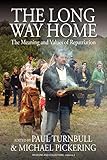The Long Way Home : The Meaning and Values of Repatriation / ed. by Michael Pickering, Paul Turnbull.
Material type: TextSeries: Museums and Collections ; 2Publisher: New York ; Oxford : Berghahn Books, [2010]Copyright date: ©2010Description: 1 online resource (224 p.)Content type:
TextSeries: Museums and Collections ; 2Publisher: New York ; Oxford : Berghahn Books, [2010]Copyright date: ©2010Description: 1 online resource (224 p.)Content type: - 9781845459581
- 9781845459598
- 174/.99301 22
- CC79.5.H85 L66 2010eb
- online - DeGruyter
| Item type | Current library | Call number | URL | Status | Notes | Barcode | |
|---|---|---|---|---|---|---|---|
 eBook
eBook
|
Biblioteca "Angelicum" Pont. Univ. S.Tommaso d'Aquino Nuvola online | online - DeGruyter (Browse shelf(Opens below)) | Online access | Not for loan (Accesso limitato) | Accesso per gli utenti autorizzati / Access for authorized users | (dgr)9781845459598 |
Frontmatter -- Contents -- Acknowledgements -- Introduction -- Part I Ancestors, Not Specimens -- 1 The Meanings and Values of Repatriation -- 2 Repatriating Our Ancestors: Who Will Speak for the Dead? -- Part II Repatriation in Law and Policy -- 3 Museums, Ethics and Human Remains in England: Recent Developments and Implications for the Future -- 4 Legal Impediments to the Repatriation of Cultural Objects to Indigenous Peoples -- 5 Parks Canada’s Policies that Guide the Repatriation of Human Remains and Objects -- Part III The Ethics and Cultural Implications of Repatriation -- 6 What Might an Anthropology of Cultural Property Look Like? -- 7 Repatriation and the Concept of Inalienable Possession -- 8 Consigned to Oblivion: People and Things Forgotten in the Creation of Australia -- Part IV Repatriation and the History of Scientific Collecting of Indigenous Remains -- 9 The Vermillion Accord and the Significance of the History of the Scientific Procurement and Use of Indigenous Australian Bodily Remains -- 10 Eric Mjöberg and the Rhetorics of Human Remains -- Part V Museums, Indigenous Peoples and Repatriation -- 11 Scientific Knowledge and Rights in Skeletal Remains – Dilemmas in the Curation of ‘Other’ People’s Bones -- 12 Despatches From The Front Line? Museum Experiences in Applied Repatriation -- 13 ‘You Keep It – We are Christians Here’: Repatriation of the Secret Sacred Where Indigenous World-views Have Changed -- 14 The First ‘Stolen Generations’: Repatriation and Reburial in Ngarrindjeri Ruwe (country) -- Notes on Contributors -- Index
restricted access online access with authorization star
http://purl.org/coar/access_right/c_16ec
Indigenous peoples have long sought the return of ancestral human remains and associated artifacts from western museums and scientific institutions. Since the late 1970s their efforts have led museum curators and researchers to re-evaluate their practices and policies in respect to the scientific uses of human remains. New partnerships have been established between cultural and scientific institutions and indigenous communities. Human remains and culturally significant objects have been returned to the care of indigenous communities, although the fate of bones and burial artifacts in numerous collections remains unresolved and, in some instances, the subject of controversy. In this book, leading researchers from a wide range of disciplines in the humanities and social sciences reflect critically on the historical, cultural, ethical and scientific dimensions of repatriation. Through various case studies they consider the impact of repatriation: what have been the benefits, and in what ways has repatriation given rise to new problems for indigenous people, scientists and museum personnel. It features chapters by indigenous knowledge custodians, who reflect upon recent debates and interaction between indigenous people and researchers in disciplines with direct interests in the continued scientific preservation of human remains. In this book, leading researchers from a wide range of disciplines in the humanities and social sciences reflect critically on the historical, cultural, ethical and scientific dimensions of repatriation. Through various case studies they consider the impact of repatriation: what have been the benefits, and in what ways has repatriation given rise to new problems for indigenous people, scientists and museum personnel. It features chapters by indigenous knowledge custodians, who reflect upon recent debates and interaction between indigenous people and researchers in disciplines with direct interests in the continued scientific preservation of human remains.
Mode of access: Internet via World Wide Web.
In English.
Description based on online resource; title from PDF title page (publisher's Web site, viewed 25. Jun 2024)


